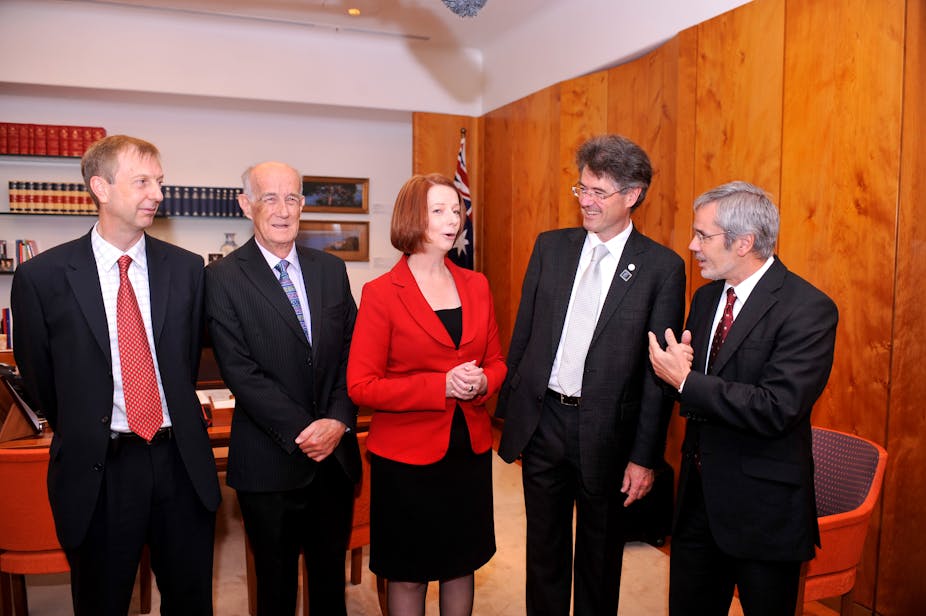Amid the hullabaloo about the carbon tax and Clean Energy Future plan, few seem to spot its critical discrepancy. It recognises that maintaining a safe climate requires stabilising carbon pollution in the atmosphere well below the levels around which the plan is built.
Opening a major climate conference in Melbourne this week, Peter Christoff summed up the plan as a “politically astute first step” among the “nasty, brutal and short-term debate” and “mud-wrestling over costs” that we currently have in Australia.
Christoff noted the “profound mismatch between Australia’s short-term targets and what is needed.”
The plan is politically astute because the suite of compensation and tax cuts it contains give it a chance of gaining enough public acceptance to allow the government to survive the next election.
But it is also profoundly inadequate. The emissions reduction targets it is built around will still lead to devastating impacts of climate change on a global scale in coming decades. It is setting us up to fail.
The “avalanche of science” the Prime Minister spoke of when announcing the plan tells us what we can expect to lose even if we achieve the targets the plan is based upon.
What science says
A little over a month ago the Prime Minister accepted delivery of a new report summarising climate change science, The Critical Decade.
The Prime Minister said in response to the report:
“Climate change is real. The science is clear - man-made carbon pollution is making a difference to our planet and our climate. We’ve got to get on with the job of cutting carbon pollution and having a rational debate about it.”
The report discusses how we stay within a global emissions budget that will keep the mean rise of global temperatures beneath 2°C. This is the level adopted by 114 countries, including Australia, in the 2009 Copenhagen Accord.
Holding global temperature rises beneath 2°C requires carbon dioxide in the atmosphere and other factors driving climate change to be stablised around 450 parts per million (ppm) or less. We currently have levels of 390 ppm and rising by 2 ppm each year due to our pollution.
For Australia’s most iconic ecosystem, the Great Barrier Reef, the consequences of going over 2°C and 450 ppm will be catastrophic.
Professor Ove Hoegh-Guldberg, one of the world’s leading experts on the impacts of climate change and ocean acidification on coral reefs, tells us, “any semblance of reefs to the coral reefs of the Great Barrier Reef Marine Park today would vanish”.

The Clean Energy Future plan recognises these consequences:
“Studies indicate that warming of more than 2 degrees Celsius will overwhelm the capacity of many of our natural ecosystems to adapt. With that level of warming, for instance, the survival of the Great Barrier Reef will be in jeopardy as higher ocean temperatures and acidity levels cause major changes to coral reefs.”
Where the plan will take us
The Clean Energy Future plan says quite a bit about stabilising carbon dioxide around 450 ppm in the atmosphere, thereby allowing mean global temperature rises of 2°C. The long-term goal to reduce Australia’s carbon pollution by 80% by 2050 is based on this target.
The trouble is that the compensation package and the rest of the plan are based around a 5% reduction in Australia’s emissions by 2020 - a target that is based on stabilising carbon dioxide around 550 ppm in the atmosphere, thereby allowing mean global temperature rises of 3°C. The opposition’s “direct action” approach is also based on this target.
The modelling of the economic impacts of the plan by Treasury spells this out.
It is true that the plan proposes a new independent body, the Climate Change Authority, to advise the government so there may be stronger interim targets than 5% by 2020. But that possibility seems remote.
The government and opposition’s policies to reduce Australia’s emissions by 5% in 2020 both aim at levels of carbon pollution that are expected to be “catastrophic for the majority of coral reefs across the planet”.
The paradox is that in Australia there is bipartisan support for protecting the Great Barrier Reef at the same time as there is bipartisan support for allowing carbon pollution to exceed levels that will destroy the Great Barrier Reef.
Glass half-full
Despite the profound inadequacy of its interim targets, the Clean Energy Future plan is a positive step when compared to the likely alternative of no comprehensive national action at all.
Frank Jotzo summed this up well:
“Although the carbon pricing scheme has its warts, the negotiations between Labor, the Greens and the Independents have also produced some genuinely positive outcomes. The package will not bring big reductions in emissions in the short term, but it can be the first step on the long road to a lower-carbon economy.”
The Clean Energy Future plan is a positive step but it is still inadequate if we want to preserve a planet in which the Great Barrier Reef and other coral reefs exist in anything like their current form.
Inadequate policies rarely last because reality knocks on the door. The carbon tax and Australia’s overall policy of reducing direct emissions by 5% by 2020 will be only a warm-up event in responding to climate change.
Our policy response should be expected to escalate rapidly in the future as severe impacts of climate change are felt.
Tragically, we are choosing a crisis-driven response rather than a proactive one.

